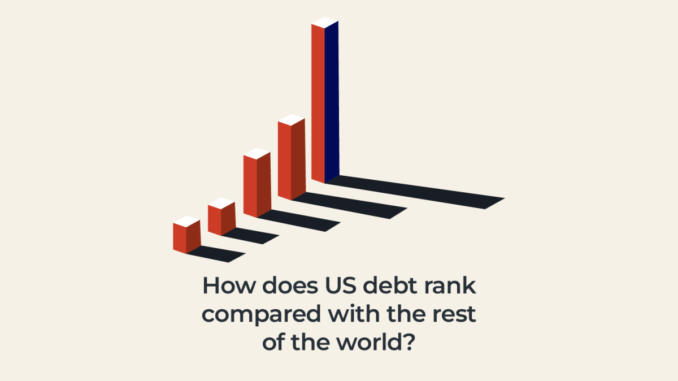
Global debt currently stands at $305 trillion, $45 trillion higher than before the COVID-19 pandemic, according to the Institute of International Finance (IIF) – a global association of the financial industry.
Global debt is the total amount of money owed by corporations, governments and individuals around the world. Of the $305 trillion of debt, corporations account for $161.7 trillion (53 percent), governments owe $85.7 trillion (28 percent) and individuals comprise $57.6 trillion (19 percent).
The IIF predicts that global debt will continue to rise as government borrowing remains high, affected by factors such as ageing populations, geopolitical tensions, increased costs of healthcare and disparities in climate finance.
Which countries have the most debt?
Government debt represents the outstanding financial liabilities of a country, made up of different categories such as loans and debt securities.
The IIF’s Global Debt Monitor covers 21 mature market economies including the eurozone as well as 30 emerging market countries.
The United States has the world’s highest national debt with $30.1 trillion owed to creditors as of the first quarter of 2023. Washington’s debt now stands at $31.4 trillion, raising further concerns about US government spending and borrowing costs.
To put that in context, the US owes as much money as the next four countries with the highest debt including China ($14 trillion), Japan ($10.2 trillion), France ($3.1 trillion) and Italy ($2.9 trillion).
The chart below ranks government debt around the world.
Which countries have enough money to pay back debts?
Countries with high levels of debt may offset their payments if their gross domestic product (GDP) – a measure of the total value of the goods and services a country produces – is higher than their national debt.
A government’s debt-to-GDP ratio, which compares the size of a country’s debt with its economy, is one indicator of a government’s financial sustainability. Any value greater than 100 percent indicates a country is spending more than it is making.
According to IIF, global governmental debt-to-GDP stands at 95.5 percent.
Japan, the world’s third largest economy, has the highest debt-to-GDP ratio at 239 percent. Tokyo’s high debt-to-GDP ratio can be partly attributed to its ageing population and social welfare costs.
Greece has the second highest debt-to-GDP ratio at 197 percent, followed by Singapore (165 percent), Italy (135 percent), and the US (116 percent).
What is the US debt ceiling?
The debt ceiling is the maximum amount of money the government can borrow. On January 19, the US hit its borrowing limit of $31.4 trillion. Since then, the Treasury has implemented a number of measures to avoid failing to pay back its legal obligations, known as a default.
A US default would likely push the country into a major recession, shake the world economy and lead to a spike in unemployment.
On May 28, after weeks of negotiations, US President Joe Biden and Republican House Speaker Kevin McCarthy, reached a tentative deal to raise the debt ceiling for two years while capping some spending.
The deal would avert a debt default if Biden and McCarthy succeed in passing it through Congress on May 31.
The United States has the world’s largest national debt at $31.4 trillion.
ENB Top News
ENB
Energy Dashboard
ENB Podcast
ENB Substack


